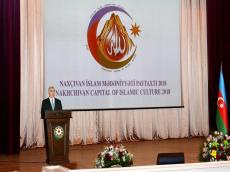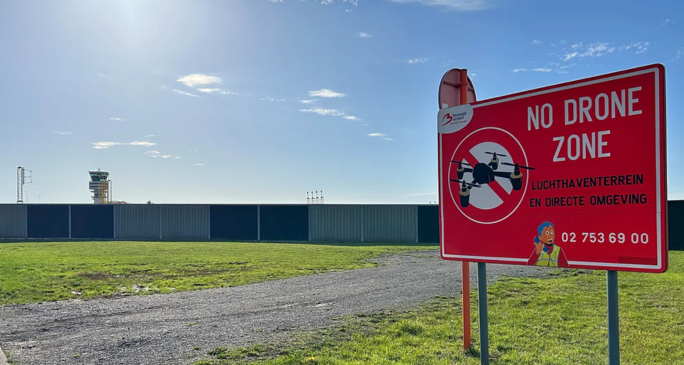|
|
TODAY.AZ / Arts & Entertainment
Nakhchivan declared Capital of Islamic Culture 2018
21 June 2018 [15:42] - TODAY.AZ

By Azernews
By Laman Ismayilova
The opening ceremony of "Nakhchivan, the Capital of Islamic Culture-2018" events was held in Nakhchivan State Musical Drama Theater on June 20.
Prior to the event, Director General of the Islamic Educational, Scientific and Cultural Organization (ISESCO) Abdulaziz Othman Altwaijri, Azerbaijan's Minister of Culture and Tourism Abulfas Garayev, Minister of Culture of Algeria Azzedine Mihoubi, Minister of Culture, Sports and Historical and Cultural Heritage of Guinea Sanosi Bantama Sou, Minister of Education and Culture of Indonesia Muhadjir Effendy, Minister of Culture of Tajikistan Shamsiddin Shodibe, Uzbek Culture Minister Bakhtiyor Sayfullaev, Secretary General of the International Turkic Culture Organization Dusen Kaseinov, President of Azerbaijan National Academy of Sciences Akif Alizade and others put flowers at the monument of national leader Heydar Aliyev.
The event participants then visited Heydar Aliyev Museum and viewed the exhibits highlighting the great leader's life, political and statehood activities.
Chairman of the Supreme Assembly of Nakhchivan Autonomous Republic Vasif Talibov handed a painting of Hachadagh to Director General of ISESCO Abdulaziz Othman Altwaijri and a painting of Batabat to Secretary General of the International Turkic Culture Organization Dusen Kaseinov.
Addressing the opening ceremony, Vasif Talibov said that Nakhchivan was proclaimed as the Islamic Culture Capital for 2018 during the 6th conference of Culture Ministers of the Organization of Islamic Cooperation in October 2009 in Baku. The decision to select Nakhchivan as the Capital of Islamic Culture is a historic event.
The chairman of the Supreme Assembly declared a series of events to be hosted by Nakhchivan in the capacity of the Capital of Islamic Culture-2018 open.
Azerbaijan's Minister of Culture and Tourism Abulfas Garayev informed participants about Nakhchivan, one of the most ancient cities of Azerbaijan.
"Historically recognized as one of the most important cities of the Near East and the Middle East, Nakhchivan has played a unique role in preserving centuries-long accomplishments of Islamic culture," the Minister said.
In his speech, Abdulaziz Othman Altwaijri stressed that Nakhchivan`s selection as the Islamic Culture Capital is a historic occasion. He expressed his gratitude to the President of Azerbaijan Ilham Aliyev for his contribution to his country and Islamic initiatives.
Abdulaziz Othman Altwaijri also thanked Chairman of the Supreme Assembly of Nakhchivan Autonomous Republic Vasif Talibov.
Nakhchivan State Philharmonic concluded the event with a gala concert.
The 6th Conference of Culture Ministers of Member States of the Organization of the Islamic Conference (OIC) held in Baku in 2009, declared Nakhchivan the Capital of the Islamic Culture in 2018.
During the discussion of proposals for determination of capitals of Islamic culture in 2015-2024, the city of Nakhchivan was elected for 2018.
To hold the event on the high level President llham Aliyev signed an executive order establishing the Organizing Committee that will deal with preparations for the events.
Under the presidential order, chairman of the Supreme Assembly of Nakhchivan Autonomous Republic Vasif Talibov was appointed head of the Organizing Committee.
Nakhchivan has plenty of fantastic tourist attractions and unique sights to offer.
One of the centuries-old cultural center of the world played an important and invaluable role in the development of Islamic culture.
It is one of the cradles of human civilization and a popular trade, art, science and cultural center of the East.
The capital of Nakhchivan Autonomous Republic, Nakhchivan city is situated on the Nakhchivan River Embankment, very close to the Iranian border, and 536 km away from Baku.
However, a folk legend says the city takes its beginning from Noah’s time, and Noah himself laid a foundation of the city after the Flood. There is Noah’s Mausoleum preserved in the southern part of the city. A temple once stood here, but unfortunately, it was destroyed, and the Mausoleum that people can visit today occupies the lower floor of the destroyed temple. There are names of pilgrims who once visited this place engraved upon the walls of this unique monument.
The splendid 12th-century Momine Khatun mausoleum, which is the city's icon, is perhaps the finest single antique monument in Azerbaijan. Built in 1186 by Acami Abubakiroglu Nakhchivani above a vaulted crypt it sits on a shallow base made of large blocks of red diorite. A flat roof raised on a tapering, decagonal drum covers the slightly pointed inner dome.
The extraordinary view of the Alinjagala (Alanjik) fortress attracts many foreign visitors. The fortress, which is perceived as a symbol of strength and military strategy, for centuries has been a critical geostrategic castle.
The walls of the fortress begin from the slopes of the Alinja Mountain and rise until fully embracing the top of the mountain. Its foundations were built of big stones and burned bricks brought from the nearby villages.
Fortress is on the top of the mountain of the same name, on the right bank of Alinjachay, Julfa region. In the oldest sources it is written in many versions such as "Erinjag", "Erinjik", "Alanjik", "Alinja", and "Alanjug".
There are different assumptions about the construction date of the castle. Some historians think that it is 2,000-year castle. Alinja is depicted as strong fortress in "Kitab-i Dada Gorgud" epos.
The remainders of the beautiful palaces and buildings belonging to the feudals in the Alinjagala were depicted in the literature of the XIX century. It was possible to keep a herd of horses and cattles before and other military ammunition in the fortress. In the rein of Atabaylar-Eldagizlar dynasty in the territory of Azerbaijan, the importance of the Alinjagala rose turning the place a shelter for the security of the rulers’ families, which was considered the most strategic military fortification.
In accordance with the Decree of the Chairman of the Supreme Assembly of Nakhchivan Autonomous Republic on February 11, 2014, "On the restoration of historical monument Alinjagala", the castle was restored and granted a status of historical and cultural museum-reserve.
The region abounds with historical monuments, including ancient Gamigaya, Farhad house, Ajhabi-Kahf, Yusuf ibn Kuseyr tomb,Tomb of the Gulistan, Khanagah tomb, Qazanchi bridge, Nakhchivan Juma Mosque, and Qesariyya monument.
Nakhchivan’s main attraction for tourists today is the therapeutic salt caves of Mount Duzdag located at a height of 1,173 meters above sea level. Those who suffer with respiratory disease find great results of treatment procedures here.
/t_CapitalofIslamicCulture1.jpg)
/t_CapitalofIslamicCulture19.jpg)
/t_CapitalofIslamicCulture2.jpg)
/t_CapitalofIslamicCulture3.jpg)
/t_CapitalofIslamicCulture4.jpg)
/t_CapitalofIslamicCulture5.jpg)
/t_CapitalofIslamicCulture6.jpg)
/t_CapitalofIslamicCulture7.jpg)
/t_CapitalofIslamicCulture8.jpg)
/t_CapitalofIslamicCulture9.jpg)
URL: http://www.today.az/news/entertainment/171212.html
 Print version
Print version
Connect with us. Get latest news and updates.
See Also
- 12 November 2025 [15:33]
UNESCO to celebrate 550th anniversary of Ashig Dirili Gurbani - 12 November 2025 [14:16]
Baku Choreography Academy holds roundtable discussion - 12 November 2025 [13:21]
Lankaran Cinema Days offer cultural journey through cinema - 12 November 2025 [12:23]
Azerbaijani literature section opens at Albanian National Library - 11 November 2025 [18:50]
Gala concert celebrates Azerbaijani composer Hajibeyli’s 140th anniversary in New York - 10 November 2025 [12:04]
National Carpet Museum unveils “C?ngi” carpet honouring fifth anniversary of Victory - 09 November 2025 [17:20]
Azerbaijan State Academic Opera and Ballet Theatre holds concert dedicated to fifth anniversary of victory - 07 November 2025 [14:58]
Ganja State Philharmonic Hall to hold concert 'Eternal Brotherhood' - 07 November 2025 [14:41]
Azerbaijani carpet gifted to Poland's Museum of Asia and Pacific on eve of Victory Day - 07 November 2025 [11:23]
Exhibition 'Knots of Time' opens at Bolnisi Museum in Georgia
Most Popular
 Historic White House visit for Syria’s Sharaa as US pushes for Abraham Accords participation
Historic White House visit for Syria’s Sharaa as US pushes for Abraham Accords participation
 Baku emerges as key pivot in Trump’s vision for new Eurasian economic map
Baku emerges as key pivot in Trump’s vision for new Eurasian economic map
 Azerbaijan hands over COP presidency to Brazil at COP30 opening ceremony
Azerbaijan hands over COP presidency to Brazil at COP30 opening ceremony
 Armenian passion for Kazakh wheat
Armenian passion for Kazakh wheat
 UK deploys personnel and equipment to assist Belgium against mysterious drones
UK deploys personnel and equipment to assist Belgium against mysterious drones
 Ferry from Trabzon denied entry to Sochi port
Ferry from Trabzon denied entry to Sochi port
 India’s Armenia strategy backfires as Azerbaijan deepens ties with China and Pakistan
India’s Armenia strategy backfires as Azerbaijan deepens ties with China and Pakistan
